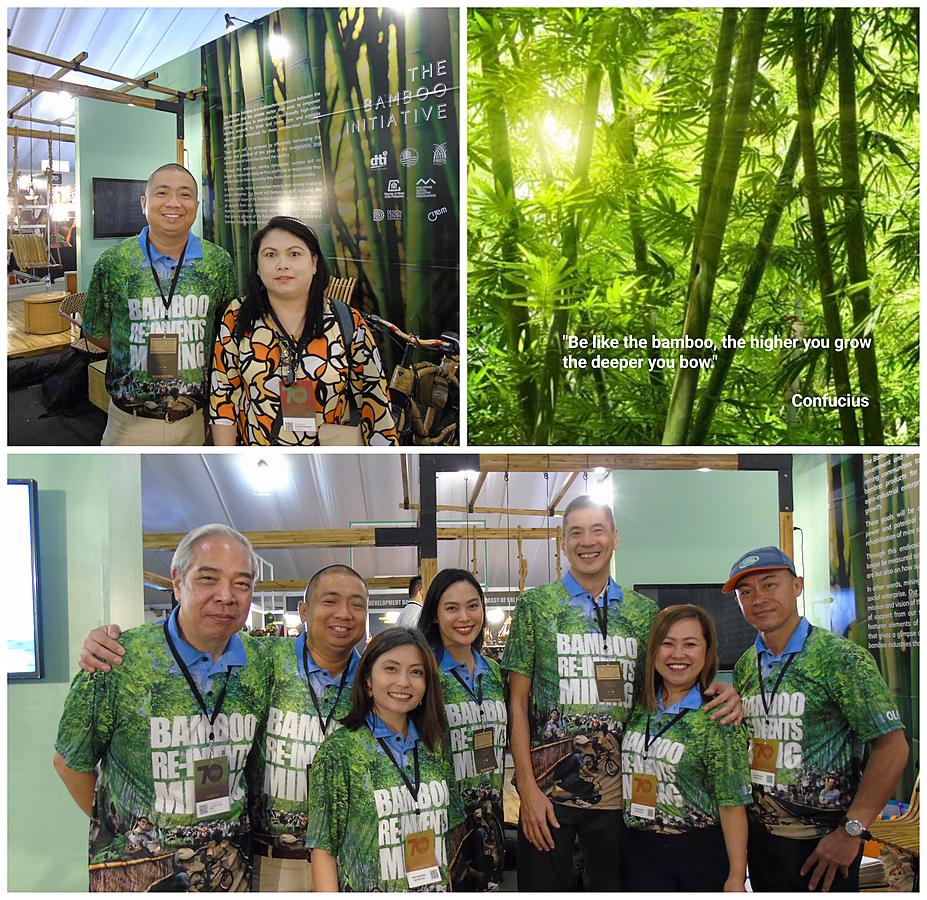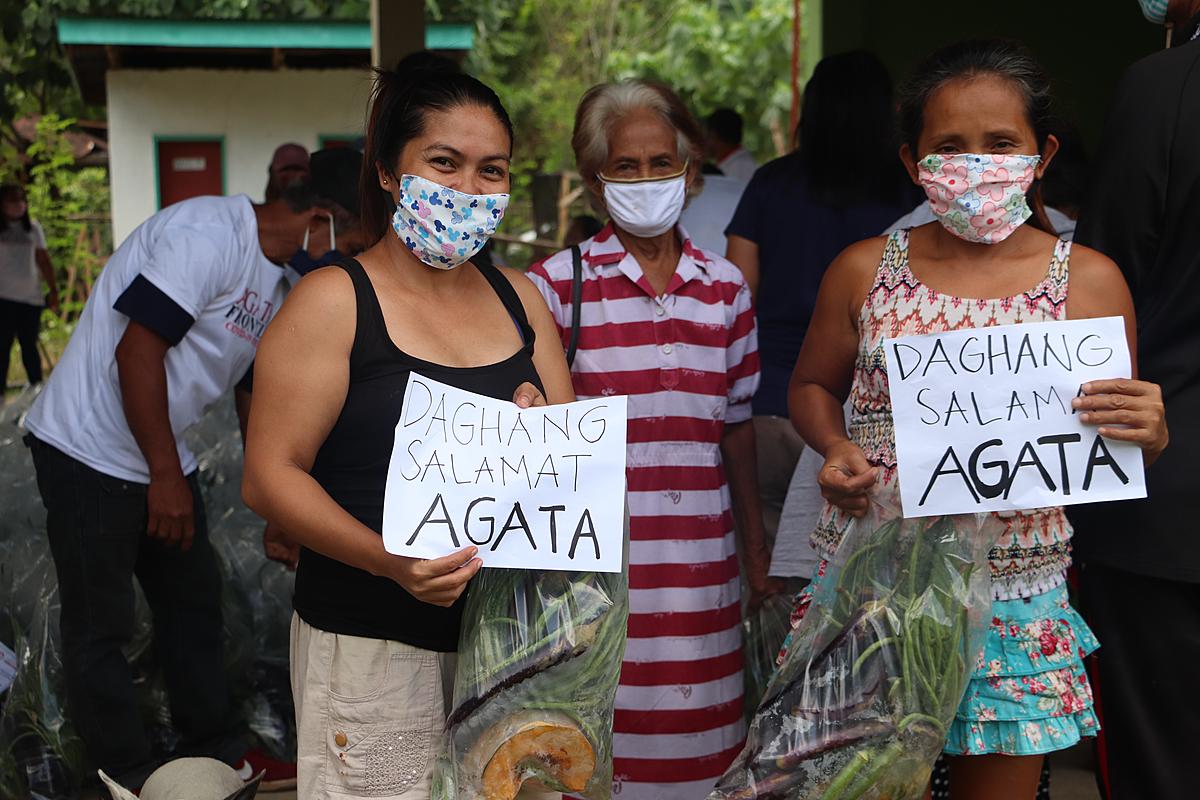2019 Manila FAME at World Trade Center - (Top photo) Joseph Castillo (a.k.a. Joe Green) with the author. (Lower photo) Joseph Castillo (second from left) with his teammates in The Bamboo Initiative -- Jose Camus, Stephen Araneta and Aisa dela Cruz of OLLI, Larissa Alivio of Bamboo Initiative, and more. (Photo by Marcelle P. Villegas, Philippine Resources Journal)
From bamboo charcoal to raw material for antibacterial fabric, environmental advocate Joe Green shares the unique and fascinating ways the bamboo plant helps mining companies and local communities. Plus with bamboo around, the cutting of trees will be lessened.
During the formal launching of The Bamboo Initiative last year at the Manila FAME, it was stated that “The Bamboo Initiative is a nationwide campaign aimed at revegetating mined-out areas with fast-growing bamboo, thereby increasing bamboo production and creating lucrative enterprises for mining communities.” [1]
The Bamboo Initiative was inspired and co-established by OLLI Consulting Group, Inc. under its CSR component “OLLI Cares” led by their President and Principal, Atty Leo Dominquez. The initiative is supported by and is a collaboration among the Chamber of Mines of the Philippines, Philippine Nickel Industry Association (PNIA), Department of Environment and Natural Resources (DENR), the Department of Trade and Industry (DTI) and its Philippine Bamboo Industry Development Council, and the Department of Agriculture.
So how does The Bamboo Initiative directly help mining companies? We interviewed Mr Joseph Castillo of OLLI Consulting Group, Inc. to elaborate on the various strategies of The Bamboo Initiative in promoting ecological and industrial use of bamboo for mining companies.
Mr Joseph Castillo is from Davao City. “People call me ‘Joe Green’ because I have other green initiatives like about plastic pollution and this bamboo campaign. The Bamboo Initiative has identified a need for the supply of bamboo planting material. In this regard, I now manage a bamboo nursery that is helping to supply the needs of the mining industry for bamboo seedlings and propagules ” he stated.
Primarily, they help mining companies in planting bamboo, because most mining companies need guidance on which bamboo varieties will successfully grow in their mine site. Each mine site has a unique soil composition and soil condition after mining. The Forest Management Bureau noted that the Philippines has over 70 bamboo species where eight species are highly useful commercially. They have the local names Kauayan Tinik, Kiling, Bayog, Laak, Giant Bamboo, Bolo, Kayali and Buho. [2]
Joe mentioned, “I am focused on growing the seedlings and the bamboo propagules so we have a facility in Baracatan, Davao. There we grow the seedlings and sell them to mining companies who then use them to re-forest their mined-out areas, especially in the nickel mining industry.”
“Right now, we are supplying for the nickel mining company, CTP Construction and Mining Corporation, headed by Mr Carlo Pimentel. We are partnering with them now and supplying them 35,000 seedlings to start with. We just started so we are in the process of delivering the first few thousands to them and we're helping them plant also.”
“Before this project even started, we did our own research together. So we studied and introduced them to people who know better about bamboo. Right now they [CTP] have enough knowledge on how to grow the bamboo successfully in their mining area. CTP is a very progressive company. They listen and they are very open to new things especially with bamboo.”
Mr Joe explained why they recommend planting bamboo instead of trees. “It is common that mining companies plant trees on the land area they have finished mining on. Planting trees is still environmentally sound but after you're gone, what will the people do with the trees? If the trees planted are not fruit-bearing, most likely the people in the area will just cut them eventually.” Mr Joe added, “There is no industry around it, and with no livelihood in place, thus they will just cut the trees.”
“On the other hand, with bamboo planted in the area, there are so many industries behind it that people can benefit from even after the mining company has left the area.”
“Firstly, bamboo itself can create crafts. Secondly, the bamboo fruits are edible. Thirdly, bamboo has many uses that we are also concentrating on, like the ‘bamboo uling’ or charcoal.” He explained that by having bamboo charcoal around, people will cut less trees that they normally use for firewood. “Therefore, it is very sustainable. The manufacturing of bamboo charcoal is an industry in itself.”
He also mentioned that in terms of carbon sequestration in the atmosphere, the bamboo can clean the air four times more than regular trees. Generally, both mining companies and the community around the mine site will benefit from bamboo.
“Bamboo has a lifespan of 80 to 100 years, but it depends on the mother plant where it came from and it also depends on the species.”
I asked Mr Joe about his views on the bamboo’s growing popularity in the manufacturing of anti-aging cosmetics. “Yes, they are now being used in anti-aging beauty products because bamboo has a high level of silica. Silica is used in many ways in the cosmetic industry as well as in the medical industry, plus food supplement and vitamins industry.”
“As I know, other than for cosmetics and medical use, bamboo is also used to make fertilizer and even beer.”
In terms of time-saving choice for reforestation and revegetation, Mr Joe mentioned that bamboo is the fastest growing plant on earth. How fast does one small propagule grow to become useful or before it can be harvested? Mr Joe answered, “It depends on the species but by rule of thumb, we wait 2 to 3 years before we can harvest it. But if you say will it grow in a year’s time? Yes, it will grow very tall within a year.”
The bamboo is known to be resistant to strong winds and typhoons due to its ability to sway with the wind. Mr Joe mentioned that its unique root system adds to this survival factor. “The roots of the bamboo are very deep and are scattered. It anchors itself really well on the soil, like most grass species, so it sways with the wind. The bamboo’s stalk is also bendable and flexible, thus it doesn’t break easily during a typhoon.”
“You would hear Confucius quotes and other Asian quotes that are ancient that talk about the bamboo’s flexibility and resilience, and comparing it in real life.”
In one ancient Chinese proverb, Confucius said, "Be like the bamboo, the higher you grow the deeper you bow."
Furthermore in our discussion, Mr Joe mentioned the bamboo’s antibacterial qualities. “I know some bamboo species have antibacterial properties. I have two mentors who are well-versed with bamboo, Coach Rey Millian from Davao and Father Vic Labao of Cebu. They're the ones who told me the species that has a high antibacterial property is locally called bagakay which is endemic in the Philippines.”
“As I know, there are local underwear brands that are tagged as odor-proof because it has antibacterial fabric. They used bamboo cloth for it.”
He is referring to the bamboo genus Schizostachyum lumampao, locally known as buho or bagakay. According to “Useful Tropical Plants” website, bagakay is known for its slim and lightweight bamboo pole that can grow up to an average of 12.50 meters high. This variety is an evergreen bamboo that forms dense clumps of culms as long as 10 meters to 15 meters tall from short, woody rhizomes, with internodes measuring 25 cm to 50 cm in length. The bagakay is one of the economically important bamboos in the Philippines providing material for a wide range of uses. It grows in the wild with the wind as its main pollinator. [3]
On a final note, Mr Joe and his team in The Bamboo Initiative helps out mining companies by providing advice and hands-on support on how to successfully plant and grow bamboo in the mined-out land area . “How do we help them in the mine sites? We find out the soil composition in the area, especially for nickel mines. Some of the nutrients in the soil might be depleted due to mining. Thus we choose and recommend the right bamboo species that are drought resistant or species that are good with lime, for example. It depends on the condition of the soil in the area to be rehabilitated. We conduct studies in order to provide the best advice in choosing the right bamboo variety.”
For more information about The Bamboo Initiative, please contact Ms Maria Paula Tolentino at paula.tolentino@olli.ph.
-----
Reference
[1] Tolentino, Maria Paula (17 October 2019). "Mining industry launches bamboo development campaign at Manila FAME". The Bamboo Initiative press release for Manila FAME 2019.
[2] Tolentino, Maria Paula (27 April 2019). SEM Scribe Publishing House. "OLLI Cares Spearheads The Bamboo Initiative". Retrieved from - https://semscribepublishing.com/
[3] “Useful Tropical Plants”. Retrieved from - Schizostachyum lumampao, http://tropical.theferns.info/)










